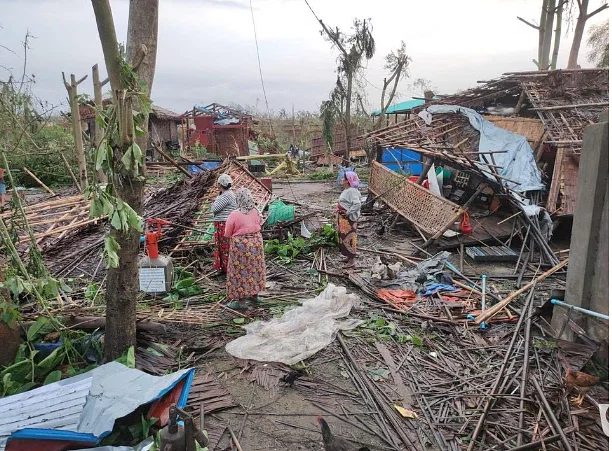
Rohingya: That was the incident before the start of atrocities against ethnic minority Rohingyas.
When I remember my childhood, I remember that my Rakhine friends used to make fun of my Rohingya classmates. I didn’t have the political awareness to understand why they did that. Other than that, as far as I can remember, most of it includes images of the Rohingya and the Rakhine—the two communities living side by side.
I was raised by a single mother. He worked as a farm laborer. But it was difficult for him to run my expenses with limited income. When I was 12 years old, he sent me to live with an uncle in Yangon, the largest city in Myanmar. But the line of cars on the road, the tall buildings, and the unfamiliar food—I lost myself. But I found myself again after joining the youth movement of the National League for Democracy led by Aung San Suu Kyi.
The National League for Democracy was a very popular party at that time. The military government also outlawed the group. It was 2001. I am 15 years old. I was arrested for incitement. I was released after five years in one of Myanmar’s most notorious prisons. Afraid of being arrested again, I fled to Thailand. I got busy earning a living and education there. I made friends with people from many countries in Thailand. I can learn from them how the human rights violations of the Rohingya people are happening under the military regime.
I also learned about some of the reasons for the growing rift between Rakhine and Rohingya. This includes Myanmar’s military junta’s continued anti-Rohingya campaign. They portrayed the Rohingya as illegal immigrants from Bangladesh. The military has been campaigning that the Rohingyas want to establish a Muslim state in Rakhine, displacing the Buddhist-majority Rakhines.
I returned to Myanmar in 2012. I met my friends and relatives in Sitte. At that time, the Myanmar military introduced a quasi-military regime in the country. Seeing this situation, Western countries started to think that positive changes are happening in Myanmar. However, the situation in Rakhine state had reached the very edge of the abyss.
Within months, riots broke out in central and northern Rakhine. Most of the Rohingya lived in this region. Rakhine and Rohingya rioters attack each other’s homes and religious places of worship. Thousands of homes were razed to the ground and more than 80 people were killed in the conflict. Rohingya and Rakhine—both sides lost their homes and loved ones. But the Rohingya also lost their freedom of movement. More than 100,000 Rohingyas are forcibly detained in refugee camps and slums in Sittwe. A deep divide developed between the Rakhine and Rohingya communities, with one community ceasing to speak to the other.
This incident makes me very sad. At the same time, the motivation to do something is created. That is why in less than a year I started an organization in Sitte to build trust and solidarity between the two communities. It was as impossible a goal as the proverb prevalent in Burmese society ‘sowing palm seeds to cover mountains’. People kept avoiding me even when I went to the tea shop, my friends stopped talking to me. Top Rakhine politicians threatened me and my companions with death.
But giving up is never an option. We keep telling Rakhine and Rohingya communities that diversity is the strength of our society. Sports, music, storytelling, mass education—we started bringing the youth of the two communities together through these activities.
Just as our efforts were gaining momentum, another blow came. In 2016, the army launched an ‘elimination campaign’ in northern Rakhine. As of 2017, the army killed 6,700 Rohingyas, and 720,000 fled to Bangladesh. Even talking about social peace and coexistence became risky at that time.
The violence started again in 2019 in my state. This time, a conflict broke out between the Myanmar army and the Arakan Army, which demanded autonomy. Rakhine people are subjected to indescribable suffering due to the military’s retaliatory attacks. But this incident is also a turning point in the relationship between Rakhine and Rohingya. This experience of horrific persecution began to bring the two communities closer together.
Then in February 2021, the military seized power in Myanmar through a coup. Since then it has become difficult for civil society organizations to continue their activities. At the same time, the military launched attacks against all ethnic and religious communities in Myanmar. As a result, awareness is created among the people of Myanmar about the phenomenon of the Rohingya population leaving the country. Unprecedented solidarity developed. Although Rakhine has been relatively less affected by the post-coup turmoil, the economic crisis and the two-month conflict between the Arakan Army and the army have left the people of the state in dire straits.
We have a long way to go to build a truly fair, just, and peaceful society in Rakhine. Discriminatory policies against the Rohingya continue, with restrictions on their movement and employment. But I see growing signs that Rakhine and Rohingya want to live side by side in peace. Trade between the people of the two communities is gradually increasing in the informal sector.